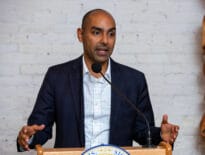Gerald W. Blakeley Jr.’s fingerprints are on many of Greater Boston’s dominant real estate development patterns of the past half-century, from the emergence of Route 128 as “America’s Technology Highway” to the growth of East Cambridge and revival of downtown Boston.
Blakeley, who died July 2 at his Osterville home at age 100, took control of Boston-based Cabot, Cabot & Forbes in 1956 as the interstate highway system was changing the way Americans lived and worked. In Needham, he built the first office park on Route 128, and developed facilities for Raytheon Corp., GTE and Polaroid in the Boston suburbs.
While suburban development threatened the viability of Boston’s downtown, Blakeley also played a role in the revival of the city during the urban renewal era. The city was struggling to replace industries such as shipbuilding and apparel manufacturing, and reshaping its image as a regional financial hub.
“Gerry was one of the most dominant figures in the post-World War II reemergence of Boston,” said Jay Doherty, CEO of Cabot, Cabot & Forbes.
In the 1960s and ’70s, Cabot, Cabot & Forbes developed many of the largest office towers in the Financial District, including One Boston Place, 100 Summer St. and 28 and 60 State St., attracting banks and insurance companies as anchor tenants. The last of those projects was the most challenging to finance during the mid-1970s recession, and members of the Boston Bruins were rumored to have joined the equity investors that succeeded in getting the project completed, Doherty said.
As the son of an MIT professor, Blakeley also sensed the potential of Cambridge forming a powerful combination of university research and private-sector investment. In the 1960s, CC&F’s Tech Square complex rose on land previously occupied by a soap factory, attracting tenants including the Polaroid Corp. headquarters, Stride-Rite and Draper Labs. In the 1990s, the neighborhood began to attract significant life science growth and has emerged as the industry’s global hub.
“Kendall Square was thought of as an adjunct to downtown Boston. Today, it is arguably more important than downtown Boston,” Doherty said.
The idea for the first office park in the Boston suburbs originated as the new Route 128 was cutting through towns such as Needham. The portion of town east of Route 128 was seen as being more palatable for development because the traffic impacts were far from the town center, Doherty said. Blakeley approached CC&F co-founder F. Murray Forbes with the notion that the former quarry could be an ideal commercial development site, leading to a job offer.
Bank of New England financed the development, called New England Industrial Center, which attracted tenants including Toyota and tire manufacturers. Many of the buildings contained a mixture of manufacturing, R&D and showroom space, a new industrial prototype that replaced the mill buildings left over from New England’s textile industry.
Blakeley’s attention to transportation’s role in real estate and economic development was legendary. Prominently displayed at the company’s office was the “CC&F map” showing planned highway projects, including the Boston extension of the Massachusetts Turnpike, along with the layout of the rail system. At the time, many of the industrial parks were served by freight service.
Blakeley grew up in Belmont and studied biochemistry and physics at Bowdoin College, before serving in the U.S. Navy during World War II.
He mentored a group of colleagues who went on to lead other commercial real estate firms, including Boston Properties co-founder Mortimer Zuckerman and Don Chiofaro of The Chiofaro Co. After selling the firm to Field Enterprises, he founded Blakeley Properties with family members.
“He really was fascinated by innovation and it really guided his entire vision of the industry,” Doherty said.




 |
| 




